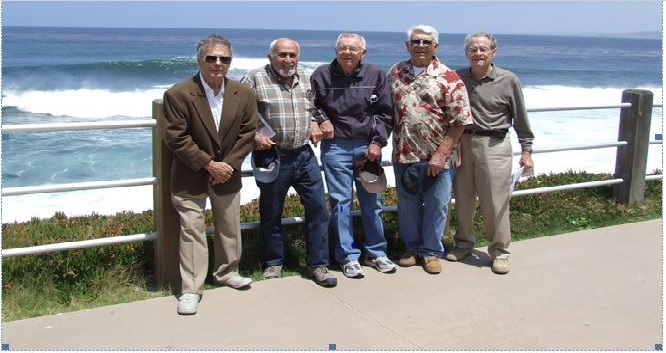
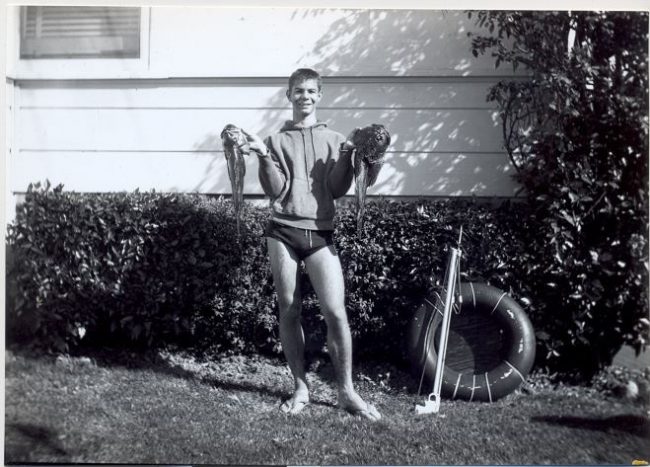

The Bottom Scratchers Skin Diving Club is the most famous and most documented La Jolla dive club, but there have been others less recognized, but still noteworthy. The Tiburones Dive Club was an informal club formed around 1957 by Gary Wickham and some Bird Rock kids.
Some of the members were: Gary Wickham, Harry Marriner, Bob Atkinson, Ronnie Prast, John Campbell, Bob Wilbur and John Warren. There may have been others, but my memory fades. It only lasted a short time and didn´t have strict requirements like the Bottom Scratchers.
One club that did have strict requirements like the Bottom Scratchers was the Manta-Ray Dive Club that was most active during the 1940s and 50s and contemporaneous with the Bottom Scratchers.

Those were the days when many skin divers and surfers hung out at “The P.B. Shack” located on the cliff at what I call Gun Point (aka: False Point, Gunnery Point, Pacific Beach Point) from around 1937-41. Don Okey “and friends” (who were they?) built this first surf/dive shack in La Jolla. Freeman D´Vincent was one of the early surfers at this site and may have also used his redwood and balsa surfboard to dive the Gun Point area.
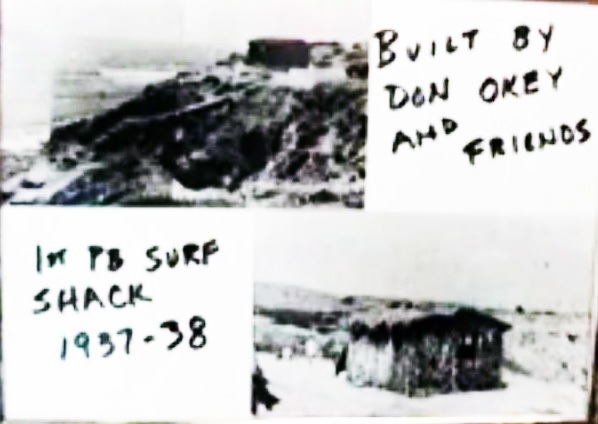
The “National Motorist” magazine (March-April 1946) wrote an article about both the Bottom Scratchers and the Manta-Rays.
At that time the requirements for joining the Bottom Scratchers (according to the article) were:
1. Haul in a very live lobster without using weapons.
2. Swim half a mile straight out to sea.
3. Outwit three abalone from a depth of 30 feet.
4. Descend to 52 feet sans helmets, etc.
5. Whosoever lands the largest specimen of the “fish-cal” year becomes Prexy and sets the pace for the others.
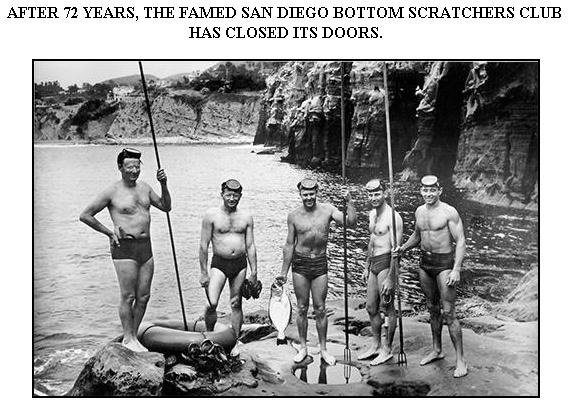
Deane Carlson and Bob Miller were two of the 15 members of the Manta-Ray Club. I´m not sure it was a requirement, but Deane had a small tattoo of a manta ray on his shoulder indicating his membership.
Deane also had “mantas” in his future. He built and administered a tuna fishing school in Manta, Ecuador and had a manta experience in Tripoli when working as a diver on an oil project. During breaks the divers slept on the sandy bottom in their dry suits instead of surfacing in the extreme heat. Once, while he was sleeping on his back on the bottom, a male manta ray thought he was a female manta ray. Deane awoke with a huge male manta ray on top of him attempting to make love. Email from Bob Miller to Harry Marriner 2, Nov. 2012:
MANTA SKIN DIVING CLUB REQUIREMENTS (Most active during the 1940s-1950s)
I found the old Manta Ray requirements for membership. We had 3 installations of 5 members for a total of 15 members. We were an immature bunch as you can see by the requirements listed:
Do the following within a 3 week period. Failure requires 4 month wait to try again. 1/3 membership vote to try to qualify:
- Swim from Scripps to the Cove.
- Bring up 20 abalone in one week and bring up 2 in one dive.
- Bare handed catch and land on shore one guitar shark in day or night.
- Catch a lobster in hands and bring it to shore.
- Retrieve one abalone at Casa Reef at 30 or more foot depth.
- Spear 3 different kinds of fish.
- Be voted in by 100% of membership.
We often brought up 3 abs from CASA reef at 30+ feet. Wasn’t too hard, the abs were lined up in every crevice generations of them lived there undisturbed for hundreds of years.

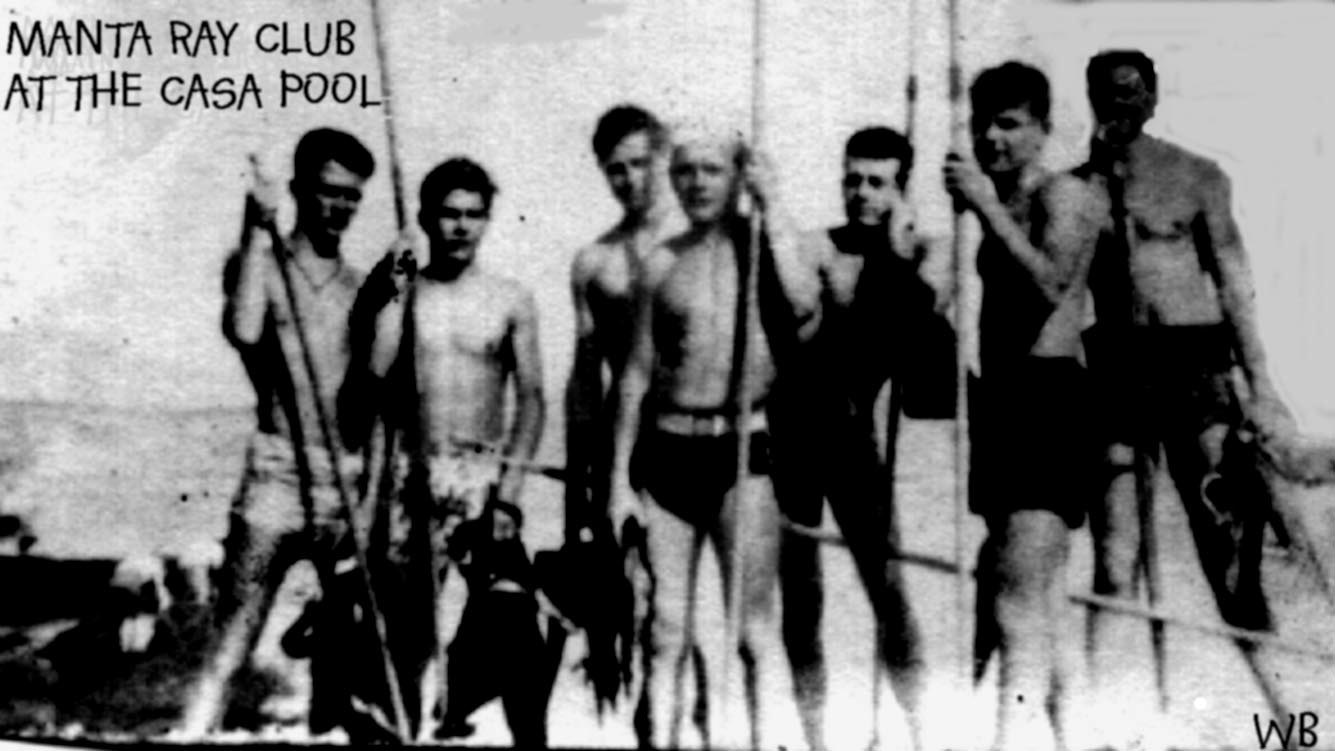
(photo courtesy of Bob Miller)
In 2012 Bob Miller identified some Manta-Ray Club members at the Casa Pool in a photo taken about 1946 as being (Left to Right):
- Fabus (Bud) Janis, SDHS, (died at my feet in diving accident in Guam 1953), was special weapons tech aboard the USS Pomfret when he died.
- Bob Miller, SDHS.
- Chuck Moelter, Sweetwater HS, deceased.
- Deane Carlson,SDHS, died 2010.
- Bob Plummer SWHS, deceased.
- Chuck Saunders, SWHS, (?? lost contact, may still be alive – last known living in Maryland).
- Al Meyer, SDHS deceased.
- Jim Stewart, the well-known Scripps Institute of Oceanography diver, was the only member of both The Bottom Scratchers and The Manta-Ray dive clubs.
Another almost-forgotten skin diving club was the Junior Maos in the 1950s sponsored by Phelps Sporting Goods store in Bird Rock
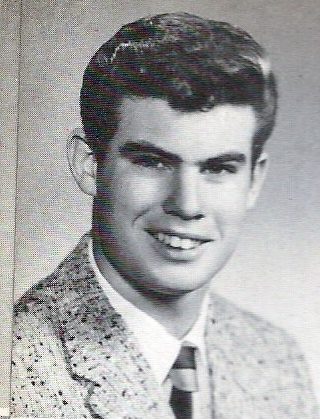
Willie Ronaldson remembers:
“Frank Leinhaupal was one of the most revered divers of the Bottom Scratchers during the fifties. Among others. His invention of the Crutch Gun for big fish was legendary. I was a member of the Jr. Maos, sponsored by Phelps Sporting goods in Bird Rock. A group of young local divers. Ronnie McConaughay, Donny Tomlinson, Frank Hetzel, Bobby Barnhill, Richard Koeppe, Billy Dunigan and Fred Renn. Fred, Ronnie and I are the last remaining. When Hub Phelps went out of business we disbanded. Good memories.”
The Tiburones Club also hung out and patronized Phelps´ Sporting goods store. One day the first blue rubber US Navy surplus dry suits arrived at Phelps’ store.
All the local skin divers bought them for around $6 and wore sweatshirts or long johns inside hoping to conquer the cold water.
They were not tight fitting and leaked around the neck soon as we got into the water. After diving we’d end up on the beach looking like ripe, leaking watermelons, but not as cold as when we went out in just our sweat suits or only a tee-shirt and cutoff jeans.
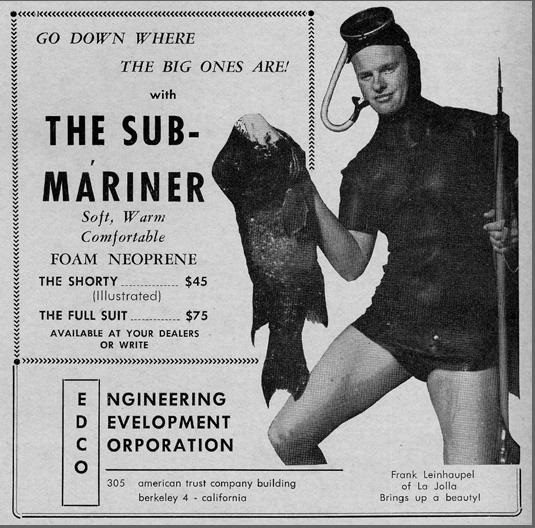
Frank and other La Jollans such as Ron Church, Mickey Church, Skip Price, Tony Ciani and Bob Shea were members of the famous and very competitive San Diego Addicts dive club.
The following is a 2012 comment on the Spearboard blog site dedicated to discussion about the “Addict” speargun on 03-03-2012, 05:17
John Warren, who interviewed Barry Wagner and Howard Benedict when preparing his excellent “Addict” speargun documentation web-page, has passed this list of San Diego Addicts Club members on to me for the information of readers here. The list was prepared by Barry Wagner in terms of those names he could then recall. At any given time there were no more than ten members. That interview was back in 2005, so some of the men mentioned below may no longer be with us. The order shown is just as the names were written down at the time.
2. Bill Howard
3. Barry Wagner
4. Tony Sanchez
5. Joe Herrin
7. Frank Leinhaupel
8. Harvey Beals
9. Larry Blackburn
10. Sets Fukuno.
12. Mickey Church
13. Don Jeans<
14. Jeff Palanick (deceased)
15. Al Larsen
For spearfishing history to survive it needs to be documented, none of us are here forever! Of course we have just heard from Harv (Harvey).
Local La Jolla lifeguard and Waterman, Skip Price, one of the most talented La Jolla skin divers during the 1960s and 70s, is not on the Addicts membership list shown above, but was an Addict member and won first place in several of their competitions. Tony Ciani, Bill Gilmore and Keller participated in the Addicts Summer 1958 Meet.
[su_row][su_column size=”1/2″ center=”no” class=””]
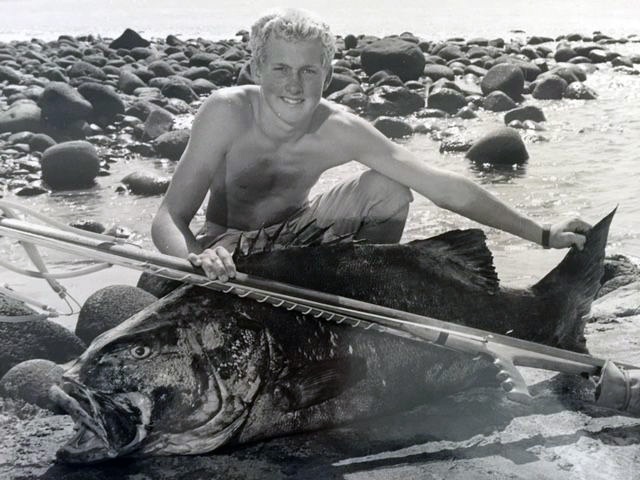
Skip also speared and landed a 57 lb. White Sea Bass on the same day. (Photo courtesy of Charlene Price)
INFLUENCE ON THE YOUTH
Early La Jolla dive clubs had a big influence on local youth inspiring them to take up the sport before the invention of fins, silicone face masks, neoprene wetsuits and SCUBA.
One of the local youths inspired by La Jolla dive club members is La Jollan Harry Crosby (born in 1926).
He was the first person in La Jolla to use Churchill swim fins.
He relates the following:
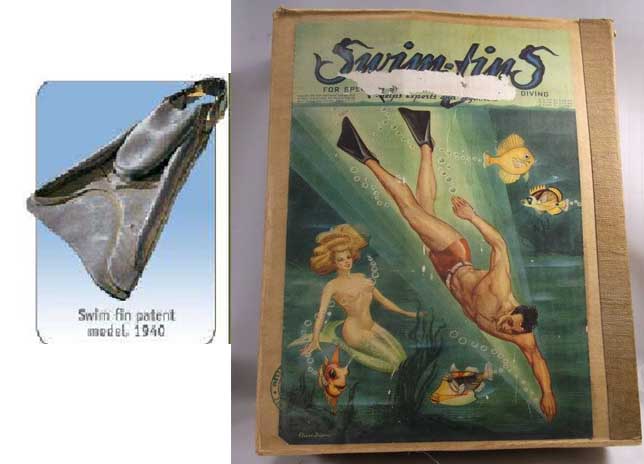
“1941 was an epochal year in my life! I got the first pair of swim fins seen in La Jolla. How? Well, I hung out some with Lois Ann (a.k.a. “Beano”) MacKay and her father, Dr. Eaton MacKay, who was second in command at Scripps Metabolic Clinic, then on Prospect across from Bishop´s School. The good doctor was an old friend of Owen Churchill who designed and manufactured the first fins sold to the public. Churchill gave MacKay a pre-distribution pair of fins, and they were too big for the doctor and I had the biggest feet (size 14) of anyone he knew so he gave them to me. I immediately went from an also ran body surfer at WindanSea to being the star of my age group. Not only that but spear fishing took on a whole new dimension. I got a 13 foot spear and cut off the 2nd and 4th tines on my spearhead. For the next two years I not only supplied my family with fish but also sold a lot of halibut and sculpin to the WindanSea Hotel which was down there at the foot of Playa del Norte, north side so it butted up with Nautilus Street.
I got virtually all my halibut in the 3- to 6-foot wide successive strips of sand lined with eel grass that stretched from the south end of Whispering Sands around Sherwood Point and ended at north WindanSea. Also got turbots there, but gave up after my first few months because no one like the strong iodine taste in turbot meat. In those days there were also sculpin and particularly calico bass off Sherwood too.”
Harry Crosby told the author about his skin diving experiences and friendship with local Botttom Scratchers when he was a youngster:
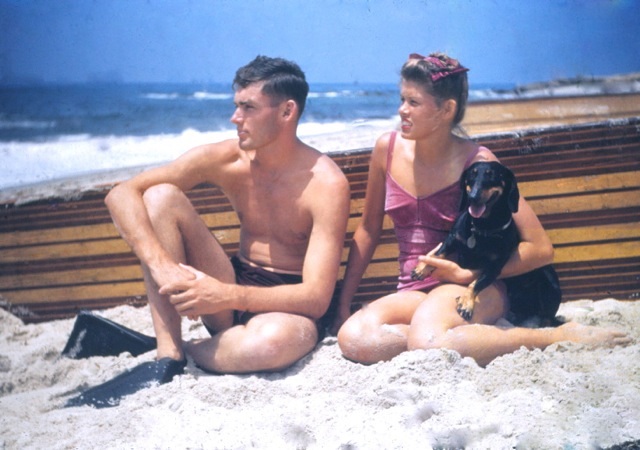
Harry and Randy Crosby with prototype Churchill swim fins. C.1941-44.
“1940-At WindanSea I got acquainted with the two of the three founding Bottom Scratchers, Wally Potts and Jack Prodonovich, when they were patrolling the shore with faceplates on their foreheads and spears in hand.
So, who were Wally Potts & Jack Prodanovich? Well, when I was a kid spearfishing and bodysurfing off WindanSea Beach, these two guys were already known as the founders of the Ocean Beach, Mission Beach, Pacific Beach, La Jolla go-go, get’em, get’em spearfishing and bodysurfing club “The Bottom Scratchers,” a group famous for its activities, its flair, its whoop-de-do. Well, I never imagined being reminded of them again, even in some roundabout way, but, hey!, today it happened. I always glance at the obituaries in the San Diego Union-Tribune and, lo and behold, this time I found an entry for the widow of Jack Prodanovich, Gertrude Prodanovich, who died this month at the age of 98. Still with us are three of their children, six grandchildren and six great-grandchildren. That’s pretty much the whole story, but seeing this obit sure brought back memories of Wally and Jack marching along Windansea and Whispering Sands, side by side and big long spears in hand.
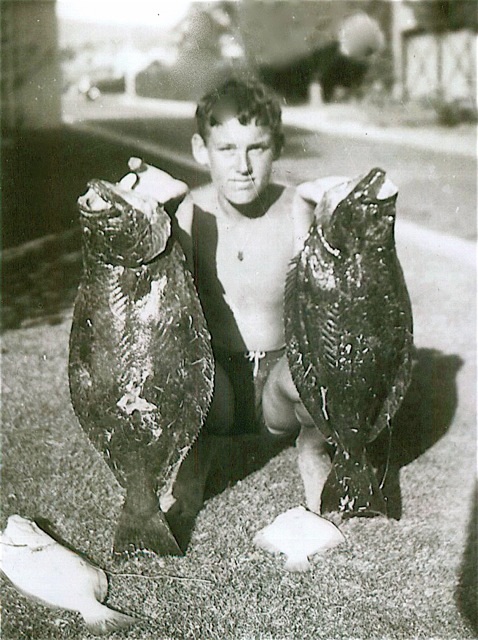
Harry Crosby and halibut he sold to the Windansea Hotel c.1938
My last spearfishing was during the spring/summer/fall of 1943. On graduation from LJHS in June of ’44 I was in the navy, then in college to graduation in ’48, grad school to 1950. But right after the war, starting in the summer of 1946, the local population of surfers and fishermen of all sorts went up exponentially. The fish population went down proportionately. And as a teacher, husband, and soon father-to-three, I was in no position to go back to sea — and then after that came Mexico, and — well, you know. That said, my years as a body surfer, spear fisherman type were over in 1944 and I never did hang out at any beach after that — except the La Jolla Rough Water Swim in 1951 and 1952 or so. My last time in that, I was, wowie zowie, First La Jolla Man!!”
Sigh . . . . . . . . that was then, and this is now . . . . .
Ah yes, I remember my ab and lobster days off Lower Hermosa and Bird Rock, many a moray encountered (but never petted), but Carl Adams did get bitten by one when he reached under a shelf to feel for abs. His index finger had three gashes down to the bone ‘cuz it bit him and he jerked his hand out; not the best reaction as it turned out.
I lived from 1940 to 1944 at 215 Avenida Cortez, the first house off of Via del Norte. I used to go down to get abs just off the rocky beach below Max Millers’ home. It was on the ocean side of Camino de la Costa I’d guess no more than a couple of hundred feet south of the junction of Vista de la Mesa and Camino de la Costa.
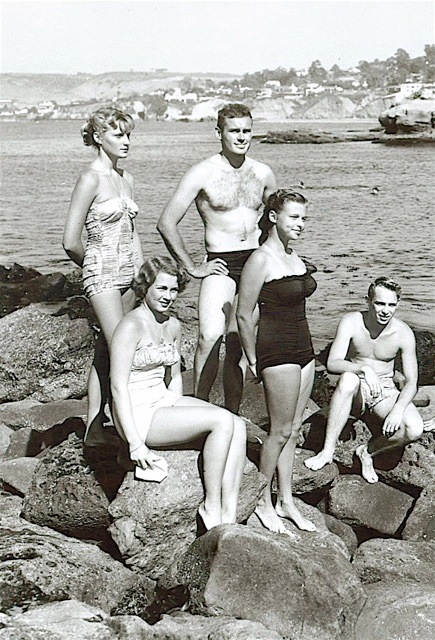
Harry Crosby (3rd from left) at Rough Water Swim La Jolla Cove c.1950
My last spearfishing was during the spring/summer/fall of 1943. On graduation from LJHS in June of ’44 I was in the navy, then in college to graduation in ’48, grad school to 1950. But right after the war, starting in the summer of 1946, the local population of surfers and fishermen of all sorts went up exponentially. The fish population went down proportionately. And as a teacher, husband, and soon father-to-three, I was in no position to go back to sea — and then after that came Mexico, and — well, you know. That said, my years as a body surfer, spear fisherman type were over in 1944 and I never did hang out at any beach after that — except the La Jolla Rough Water Swim in 1951 and 1952 or so. My last time in that, I was, wowie zowie, First La Jolla Man!!”
While skin diving in La Jolla in the early days was never easy due cold water, lack of comfortable and good fitting face masks and murky water, the sea life was abundant for those with the courage and stamina to brave the aqueous element to stock their refrigerators.
The following, summarized from the author´s dive log, shows what was available for the picking by a 14 year old kid back in 1957-1958: “I made a log of my skin diving activities from May 13, 1957 to November 20, 1958.
During those 18 months I made 25 dives in La Jolla:
- 1 at Whispering Sands (nothing caught),
- 7 at P.B. Gun Point (84 abalone, 1 lobster),
- 12 at Bird Rock (28 abalone, 6 lb. Capazone, 4.5 lb. Bass, 18 inch Sculpin, 2 -12 inch Opaleye, l lobster, 1 Stingray, usually at South Bird Rock or Bird Rock Cove),
- 1 at Bird Rock Kelp Beds (4 lb Calico Bass),
- 2 at the La Jolla Cove and Caves (9.5 inch fish),
- 1 at Casa de Manana (nothing caught),
- 1 at WindanSea (nothing caught then, but around 1960 I speared a rare deep-water fish, on the reef in front of The Hut, that had spots on its side that glowed in the dark). I left it in Ken Connors` sink where he was living on Nautilus St. and when he came home at night it glowed and scared the crap out of him. The clearest water in those 18 months was usually at Bird Rock and Gun Point during the winter months.”
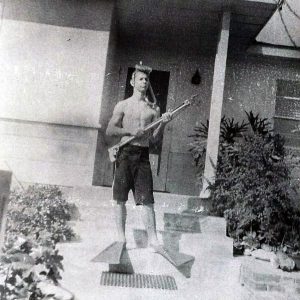
It´s amazing that there were any abalone left for skin divers in the 1950s since a newspaper article recounting the effects of the catastrophic January 1916 storm in San Diego mentions that “thousands of abalone washed ashore at Bird Rock.” Recovery must have been very slow. The abalone population before 1916 at Bird Rock must have been astronomical.
Another entry from the same dive log shows that not all the early skin divers came back to shore alive: “Monday, May 20, 1957. I was diving with Bob Wilbur and Bob Enns at Gun Point today in rough surf two blocks south of where a boy 24 years old drowned during the same time we were out.”
[su_divider margin=”25″]Thanks to HARRY MARRINER’s article on Sunday July 8, 2018, Albert, keeping with Mac Meda Tradition, most willfully borrowed (stole) this bitch’en historical part of La Jolla. Mucho Thanks Harry…
APPRECIATION
Harry Marriner would like to thank the following people for their help providing information, stories, suggestions and photos that made this article possible: Bob Miller, Melissa Moore, Gary Wickham, Chuck Snell, Tony Ciani, Bronle Crosby, Harry Crosby, John Campbell, Willie Ronaldson, Skip and Charlene Price, Frank Leinhaupal and Deane Carlson.
The La Jolla Historical Society posted a photo of the Manta-Ray Dive Club on their Facebook on July 7, 2023. It’s a wonderful photo. Do you know if any of the Manta-Ray Dive Club members are still living. I’m sure the Historical Society would love to record and oral history and put names to the faces in the photo. Thank you!
Fascination St. For me to hear all this. Bob Shea is my name. Used to deck hand at age 12 or so on my uncle Bob Shea’s ab diving boat early 1970s .Staying out in Campo with him as of late. You all rock my socks off big time. Ab’s washing up like that after that storm…. Amazing… First time I heard about it … Wow. Huge difference in the amount of biomass in our local waters now a days compared to what you guys were messing with… I know.. But u guys really and truly know. Amazing…